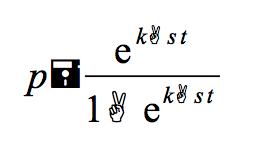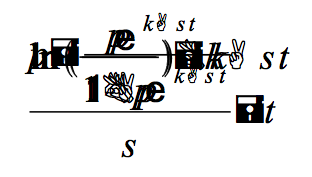Man'yōshū poem #372:
春日乎 春日山乃 高座之 御笠乃山尓 朝不離 雲居多奈引 容鳥能 間無數鳴 雲居奈須 心射左欲比 其鳥乃 片戀耳二 晝者毛 日之盡 夜者毛 夜之盡 立而居而 念曽吾為流 不相兒故荷
parupi wo/ kasuga no yama no/ takakura no/ mikasa no yama ni/ asa sarazu/ kumowi tanabiki/ kapotori no/ ma naku siba naku/ kumowi nasu/ kokoro isaywopi/ sono tori no/ katakwopwi nomwi ni/ piru pa mo/ pi no kotogoto/ yworu pa mo/ ywo no kotogoto/ tatite wite/ omopi so a ga suru/ apanu kwo yuwe ni
[On a spring day] Mount Kasuga; [The heights of] Mount Mikasa — where every morning/ the clouds cluster/ and the face-birds/ cry ceaselessly;/ like the clouds/ my heart is heavy/ like the birds/ my love unrequited;/ by day/ all day/ by night/ all night/ I stand, I sit/ I ever brood;/ for one who will not see me
That's an ugly and unpolished translation for sure, but I don't want to showcase the detail so much as the structure. Check this out:
| Text | Comment |
|---|
| [On a Spring day] | [The heights of] | makurakotoba |
| Mount Kasuga | Mount Mikasa | Natural phenomena/backdrop |
where every morning/
the clouds cluster | and the face-birds/
cry ceaselessly | Natural phenomena/actors + ceaselessness |
like the clouds/
my heart is heavy | like the birds/
my love unrequited | Simile linking nature to self |
| by day/ all day | by night/ all night | Ceaselessness (intensified, almost obsessive) |
| I stand | I sit | Actions of self |
| I ever brood | Emotions of self |
| for one who will not see me | Reason |
The poem starts out from the utterly impersonal: mountains (involved with stock epithets, no less). From there it is a jo-ha-kyū-style slowly accelerating burn through the natural actors who "inhabit" the mountains, their behavior, their behavior's relevance to the narrator, the narrator's behavior itself, a climactic and tempestuous declaration, and finally, almost as an afterthought, a placid (resigned, perhaps) explanation of why all this should be — why the poem even exists.
And all of this is presented in dual form right up until the climax of the poem, the second-last line omopi so a ga suru 念曽吾為流, a sentence which uses kakari-musubi form to emphasize the omopi, "thought (of someone)." The narrator is utterly in thrall to this omopi alone, and so it is appropriate that the A/B structure vanishes here — and note that the "tempo" of the duality has just increased, with both A and B in the same line: tatite wite.
This is the sort of thing that didn't survive when chōka ("long poems") went out of style.
Incidentally, it is no longer clear what a "face-bird" is. Maybe the cuckoo, maybe not.


![[No-sword]](http://no-sword.jp/images/site/no-sword_banner.jpg)


